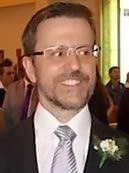 |
Ricardo M. SOUTO, Full Professor in Physical Chemistry
Institute of Materials and Nanotechnology |
Ricardo M. SOUTO
Institute of Materials and Nanotechnology
Universidad de La Laguna (Tenerife, Spain)
Abstract
This contribution provides a brief review of a relatively new technique, namely scanning electrochemical microscopy (SECM), and its applications in measuring, characterising and evaluating dynamic chemical systems in real time with high spatial resolution. Localized corrosion processes and electrochemical activity distributions in surfaces can thus be investigated in real time with high spatial resolution. The SECM is a unique near-field scanning technique that is electrochemically integrated as to detect chemical and electrochemical activities in electrochemical heterogeneous systems such as those operating in corrosion research. The SECM method can monitor local changes in composition, potentials and rates with high spatial resolution. In this technique, an ultramicroelectrode (UME), also known as the tip, and substrate are positioned within an electrochemical cell along with a reference and counter electrodes. The UME (tip) is capable moving in X-Y-Z coordinates, and thus can raster the substrate surface at any prescribed height. The current recorded by the tip is a function of the local solution composition, the tip-substrate distance and the electrochemical/electrical activity of the substrate. An image of the spatial electrochemical reactions on a sample can thus be obtained by recording/analysing the tip currents, as the tip is rastered across the substrate surface. This is because currents associated with the electrochemical reaction at the tip, experience perturbations when in close proximity with the substrate, therefore enabling one to record a chemical micrograph of the surface. Alternately, the SECM can be operated using an ion-selective microelectrode as potentiometric tip, thus providing a very high chemical selectivity. Despite the advantageous characteristics of SECM for materials characterization, the analysis of the electrochemical response recorded at the tip is often a combination of topographical and chemical changes. In addition, it is difficult to fabricate microdisk probes of submicrometer dimensions. To overcome these limitations, novel probes are designed for multifunction operation in SECM, especially combined atomic force-scanning electrochemical microscopy (AFM-SECM).